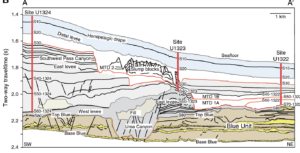Rapid sedimentation, overpressure, and focused fluid flow, Gulf of Mexico continental margin
Expedition 308 of the Integrated Ocean Drilling Program (IODP) was the first phase of a two-component project dedicated to studying overpressure and fluid flow on the continental slope of the Gulf of Mexico. We examined how sedimentation, overpressure, fluid flow, and deformation are coupled in a passive margin setting and investigated how extremely rapid deposition of fine-grained mud might lead to a rapid build-up of pore pressure in excess of hydrostatic (overpressure), underconsolidation, and sedimentary mass wasting. Our tests within the Ursa region, where sediment accumulated rapidly in the late Pleistocene, included the first-ever in situ measurements of how physical properties, pressure, temperature, and pore fluid compositions vary within low-permeability mudstones that overlie a permeable, overpressured aquifer, and we documented severe overpressure in the mudstones overlying the aquifer. We also drilled and logged three references sites in the Brazos-Trinity Basin IV and documented hydrostatic pressure conditions and normal consolidation. Post-expedition studies will address how the generation and timing of overpressure control slope stability, seafloor seeps, and large-scale crustal fluid flow. The operations of Expedition 308 provide a foundation for future long-term in situ monitoring experiments in the aquifer and bounding mudstones.

